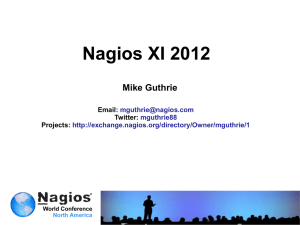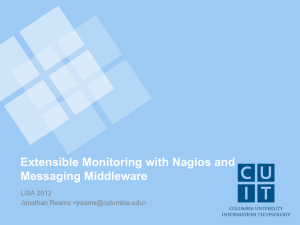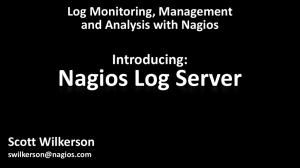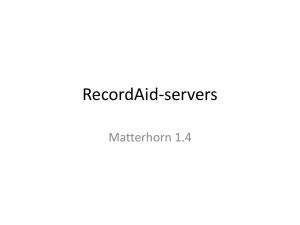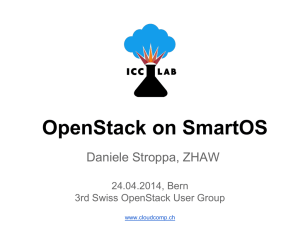PPT
advertisement
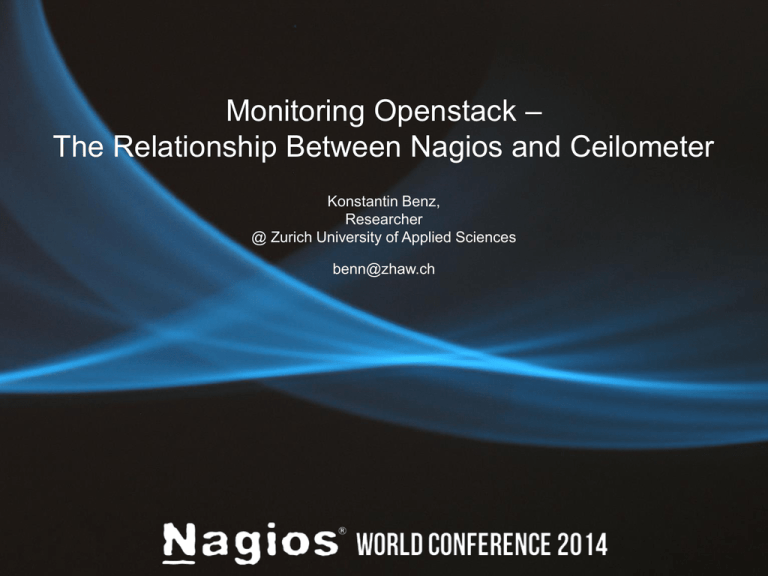
Monitoring Openstack –
The Relationship Between Nagios and Ceilometer
Konstantin Benz,
Researcher
@ Zurich University of Applied Sciences
benn@zhaw.ch
Introduction & Agenda
• About me
•
Working as researcher @
Zurich University of Applied Sciences
•
•
•
OpenStack / Cloud Computing
Engaged in monitoring and High Availability systems
Currently working on a Europe-wide cloud federation:
•
XIFI – eXtensible Infrastructure for Future
Internet
http://www.fi-xifi.eu
•
17 nodes / OpenStack clouds
•
Test environment for Future Internet (FI-WARE)
applications
•
Infrastructure for smart cities, public healthcare,
traffic management…
•
European-wide L2-connected backbone network
•
Nagios as main monitoring tool of that project
Introduction & Agenda
• What are you talking about in this presentation?
•
•
•
How to use Nagios to monitor an OpenStack cloud environment
Integrate Nagios with OpenStack
Anything else?
•
•
•
Cloud monitoring requirements
OpenStack cloud management software and Ceilometer
Comparison between Nagios and Ceilometer:
• Technological paradigms
• Commonalities and differences
•
•
How to integrate Nagios with Ceilometer
Can't wait!
Cloud Monitoring Requirements
Cloud ≈ virtualization + elasticity
• Types of clouds:
•
•
•
IaaS: virtual VMs and network devices, elasticity in number/size of
devices
PaaS: virtual, elastically sized platform
SaaS: software provided by employing virtual, elastic resources
• Cloud is a collection of virtual resources provided in physical
infrastructure
• Cloud provides resources elastically
Cloud Monitoring Requirements
Why should someone use clouds?
•
Cloud consumer can outsource IT infrastructure
•
•
•
•
No fixed costs for cloud consumer
Pay for resource utilization
Cloud provider responsible for building and maintaining physical
infrastructure
Cloud provider can rent out unused IT infrastructure
•
•
Eliminate waste
Get money back for overcapacity
Monitoring OpenStack
OpenStack
Architecture
•
•
Open source cloud computing software
Consists in multiple services:
•
•
•
•
•
•
•
•
•
Keystone: OpenStack identity services
(authentication, authorization, accounting)
Cinder: management of block storage volumes
Nova: management and provision of virtual
resources (VM instances)
Glance: management of VM images
Swift: management of object storage
Neutron: management of network resources (IPs,
routing, connectivity)
Horizon: GUI dashboard for end users
Heat: orchestration of virtualized environments
(important for providing elasticity)
Ceilometer: monitoring of virtual resources
Monitoring OpenStack
Things to monitor
•
•
Operation of OpenStack itself:
• Services: Cinder, Glance, Nova, Swift ...
• Infrastructure: Hardware, Operating System where OpenStack services are running
Operation of virtual resources provided by OpenStack:
•
Resource availability: VMs, virtual network devices
•
Resource utilization: VM uptime, CPU / memory usage
→ Virtual resources are commonly monitored by Ceilometer
→ Ceilometer gathers data
through the API of
OpenStack services
Monitoring OpenStack
Why is Ceilometer not enough?
→ Ceilometer monitors virtual resources through APIs of OpenStack
components, BUT NOT operation of the OpenStack components
Comparison Nagios / Ceilometer
Nagios operational model
•
Configuration:
•
Check interval (and retry interval) to poll system status and update frontend GUI
•
Remote execution of monitoring clients (usually Nagios plugins)
•
Thresholds that result in "Okay", "Warning", "Critical" status messages which are sent
back to Nagios server (and "Unknown" if status not measurable)
Main usage:
•
Effective monitoring solution for physical servers
•
System administration console that allows for fast reaction in case of problems
•
Strength: extensibility and customizability
•
Nagios must be extended in order to monitor virtual resources inside administrated
systems
Comparison Nagios / Ceilometer
Ceilometer operational model
•
Configuration:
•
Polling services check metrics
•
OpenStack objects generate event notifications automatically
•
All events and metrics collected in a database
Main usage:
•
OpenStack integrated metrics collector and database
•
Temporal database that can be used for rating, charging and billing of virtual resource
utilization
•
Strength: fully integrated in OpenStack, collecting most important metrics and storing
their change history
•
Weakness: Does not monitor physical hosts
Nagios / OpenStack Integration
•
Alternative 1: Ceilometer Plugin in Nagios
Use Nagios server as frontend for Ceilometer:
•
Nagios plugin that queries Ceilometer database
•
Virtual resource utilization data collected by Ceilometer
•
Nagios server responsible for monitoring non-virtual resources
Benefits:
•
•
•
Drawbacks:
•
Simple and easy to implement
No extra Nagios plugins required to monitor virtual devices that are managed within OpenStack
Ceilometer tool can be left unchanged
Monitoring data is stored at 2 different places: Nagios flat file and Ceilometer database
Nagios / OpenStack Integration
•
Alternative 1: Ceilometer Plugin in Nagios
Implementation:
•
Nagios plugin on client which hosts the Ceilometer API (code sample below)
•
Initialization with default values, OpenStack authentication:
#!/bin/bash
#initialization with default values
SERVICE='cpu_util'
THRESHOLD='50.0'
CRITICAL_THRESHOLD='80.0'
#get openstack token to access ceilometer-api
export OS_USERNAME="youruser"
export OS_TENANT_NAME="yourtenant"
export OS_PASSWORD="yourpassword"
export OS_AUTH_URL=http://yourkeystoneurl:35357/v2.0/
Nagios / OpenStack Integration
•
Alternative 1: Ceilometer Plugin in Nagios
The plugin should receive paramaters for:
• Resource to be monitored (VM)
• Service (Ceilometer metric)
• Warning threshold
• Critical threshold
while getopts ":hs:t:T:" opt
do
case $opt in
h ) printusage;;
r ) RESOURCE=${OPTARG};;
s ) SERVICE=${OPTARG};;
t ) THRESHOLD=${OPTARG};;
T ) CRITICAL_THRESHOLD=${OPTARG};;
? ) printusage;;
esac
done
Nagios / OpenStack Integration
•
Alternative 1: Ceilometer Plugin in Nagios
Query Nova API to get resource to monitor (VM to be monitored):
RESOURCE=$(nova list | grep $RESOURCE | tail -2 | head -1 | awk -F '|' '{print $2; end}')
RESOURCE=$(echo $RESOURCE)
•
Query metric on that resource, multiple entries possible requires an iterator):
ITERATOR=$(ceilometer meter-list -q "resource_id=$RESOURCE" | grep -w $SERVICE | awk 'END{print NR; end}')
•
Initialize with return code 0 (no warning or error):
RETURNCODE=0
Nagios / OpenStack Integration
•
Alternative 1: Ceilometer Plugin in Nagios
Iterate through metric:
for (( C=1; C<=$ITERATOR; C++ ))
do
METER_NAME=$(ceilometer meter-list -q "resource_id=$RESOURCE" | grep -w $SERVICE | awk -F '|' -v var="$C" '{if (NR == var)
{print $2 $1; end}}')
METER_UNIT=$(ceilometer meter-list -q "resource_id=$RESOURCE" | grep -w $SERVICE | awk -F '|' -v var="$C" '{if (NR == var)
{print $4 $1; end}}')
RESOURCE_ID=$(ceilometer meter-list -q "resource_id=$RESOURCE" | grep -w $SERVICE | awk -F '|' -v var="$C" '{if (NR == var)
{print $5 $1; end}}')
ACTUAL_VALUE=$(ceilometer sample-list -m $METER_NAME -q "resource_id=$RESOURCE" -l 1 | grep $RESOURCE_ID | head -4 |
tail -1| awk -F '|' '{print $5; end}')
Nagios / OpenStack Integration
•
Alternative 1: Ceilometer Plugin in Nagios
Update return code if value of one metric is above a threshold:
if [ $(echo "$ACTUAL_VALUE > $THRESHOLD" | bc) -eq 1 ]
then
if (( "$RETURNCODE" < "1" ))
then
RETURNCODE=1
fi
if [ $(echo "$ACTUAL_VALUE > $CRITICAL_THRESHOLD" | bc) -eq 1 ]
then
if (( "$RETURNCODE" < "2" ))
then
RETURNCODE=2
Nagios / OpenStack Integration
•
Alternative 1: Ceilometer Plugin in Nagios
Output return code:
STATUS=$(echo "$METER_NAME on $RESOURCE_ID is: $ACTUAL_VALUE $METER_UNIT")
echo $STATUS
done
echo $RETURNCODE
Nagios / OpenStack Integration
Alternative 1: Ceilometer Plugin in Nagios
•
Plugin can be downloaded from Github:
• https://github.com/kobe6661/nagios_ceilometer_plugin.git
•
Additionally:
• NRPE-Plugin: remote execution of Nagios calls to Ceilometer
• Install NRPE on Nagios Core server and server that hosts Ceilometer API
• Change nrpe.cfg to include call to VM metric
Nagios / OpenStack Integration
Alternative 1: Implementation
•
OpenStack installed on 3 nodes:
•
•
•
Management node: responsible for monitoring other OpenStack nodes
Controller node: responsible for management and configuration of cloud resources (VMs,
network)
Compute node: provisions virtual resources
Nagios / OpenStack Integration
•
Alternative 2: Nagios OpenStack Plugins
Nagios as a tool to monitor OpenStack services and VMs:
•
Plugins to monitor health of OpenStack services
•
As soon as new VMs are created, Nagios should monitor them
•
Requires elastic reconfiguration of Nagios
Benefits:
•
No data duplication, Nagios is the only monitoring tool required to monitor OpenStack
Drawbacks:
•
•
Elastic reconfiguration
Rather complex Nagios configuration
Nagios / OpenStack Integration
•
Alternative 2: Nagios OpenStack Plugins
Problem:
• Dynamic provisioning of resources (Virtual Machines)
• Dynamic configuration of hosts in Nagios Server required
MONITORS
Nagios
Server
OpenStack
Controller
Node
VM Image
PROVIDES
Virtual Machine
OpenStack
Compute
Node
Nagios / OpenStack Integration
•
Alternative 2: Nagios OpenStack Plugins
Problem:
• What happens if VM is terminated by end user?
• Nagios assumes a host failure and produces a critical warning
MONITORS
Nagios
Server
OpenStack
Controller
Node
VM Image
PROVIDES
Virtual Machine
OpenStack
Compute
Node
Nagios / OpenStack Integration
•
Alternative 2: Nagios OpenStack Plugins
Solution:
• Nova-API triggers reconfiguration of Nagios if VMs are created or terminated
RECONFIGURES
Nagios
Server
OpenStack
Controller
Node
VM Image
PROVIDES
Virtual Machine
OpenStack
Compute
Node
Nagios / OpenStack Integration
•
•
Alternative 2: Nagios OpenStack Plugins
Another problem:
• VMs must have Nagios plugins installed when they are created
Solution:
• Use only VM Images that contain Nagios plugins for VM creation OR
• Use package management tools like Puppet, Chef…
Nagios
Server
OpenStack
Controller
Node
NRPE Plugins
VM Image
NRPE Plugins
PROVIDES
Virtual Machine
OpenStack
Compute
Node
Nagios / OpenStack Integration
•
Alternative 2: Nagios OpenStack Plugins
Trigger for dynamic Nagios configuration:
• Find available resources via nova-api (requires name of host and IP address)
#!/bin/bash
NUMLINES=$(nova list | wc -l)
NUMLINES=$[$NUMLINES-3]
for (( C=1; C<=$ITERATOR; C++ ))
do
VM_NAME=$(nova list | tail -$NUMLINES | awk -F'|' -v var="$I" '{if (NR==var){print $3 $1;end}}')
IP_ADDRESS=$(nova list | tail -$NUMLINES | awk -F'|' -v var="$I" '{if (NR==var){print $7 $1;end}}' | sed 's/[a-zA-Z0-9]*[=|-]//g')
Nagios / OpenStack Integration
•
Alternative 2: Nagios OpenStack Plugins
Trigger for dynamic Nagios configuration:
• Create a config file including VM name and IP address from a template (e. g. vm_template.cfg)
CONFIG_FILE=$(echo $VM_NAME).cfg
sed "s/<vm_name>/$VM_NAME/g" vm_template.cfg>named_template.cfg
sed "s/<ip_address>/$IP_ADDRESS/g" named_template.cfg>$CONFIG_FILE
•
Set Nagios as owner of the file and move file to Nagios configuration directory
chown nagios.nagios $CONFIG_FILE
chmod 644 $CONFIG_FILE
mv $CONFIG_FILE /usr/local/nagios/etc/objects/$CONFIG_FILE
Nagios / OpenStack Integration
•
Alternative 2: Nagios OpenStack Plugins
Trigger for dynamic Nagios configuration:
• Add config file to nagios.cfg
echo "cfg_file=/usr/local/nagios/etc/objects/$CONFIG_FILE" >> /usr/local/nagios/etc/nagios.cfg
•
Restart nagios
service nagios restart
Nagios / OpenStack Integration
•
Alternative 2: Nagios OpenStack Plugins
Why restart Nagios?
• Nagios must know that a new VM is present or that an old VM has been terminated
• Reconfigure and restart Nagios (!)
Nagios / OpenStack Integration
•
Alternative 2: Nagios OpenStack Plugins
Trigger for dynamic Nagios configuration:
• Add trigger to Nova-API:
•
•
Nagios Event Broker module:
•
Check_MK: http://mathias-kettner.de/checkmk_livestatus.html
Reconfigure Nagios dynamically:
•
•
Edit nagios.cfg and restart Nagios – bad idea (!!) in a cloud environment
Autoconfiguration tools:
•
NagioSQL: http://www.nagiosql.org/documentation.html
Nagios / OpenStack Integration
•
Alternative 2: Nagios OpenStack Plugins
What other ways do exist to dynamically reconfigure Nagios?
• Puppet master that triggers:
•
•
VMs to install Nagios NRPE plugins and
Nagios Server to update its configuration
•
Same can be done with Chef, Ansible…
•
Drawback:
Puppet scalability if 1‘000s of servers have to be (de-)commisioned dynamically
Nagios / OpenStack Integration
•
Alternative 2: Nagios OpenStack Plugins
What other ways do exist to dynamically reconfigure Nagios?
• Python fabric with Cuisine to trigger:
•
•
VMs to install Nagios NRPE plugins and
Nagios Server to update its configuration
•
Get list of VMs
from novaclient.client import Client
nova = Client(VERSION, USERNAME, PASSWORD, PROJECT_ID, AUTH_URL)
servers = nova.servers.list()
•
Write VM list to file
file = open('servers'‚ 'w')
file.write(servers)
Nagios / OpenStack Integration
•
Alternative 2: Nagios OpenStack Plugins
What other ways do exist to dynamically reconfigure Nagios?
• Python fabric with Cuisine to trigger:
•
•
•
VMs to install Nagios NRPE plugins and
Nagios Server to update its configuration
Create fabfile.py and define which servers should be configured
from fabric.api import *
from . import vm_recipe, nagios_recipe
env.use_ssh_config = True
servers=open('servers‘)
serverlist=[str(line) for line in servers]
env.roledefs = {‘vm': serverlist,
‘nagios_server': xx.xx.xx.xx
}
Nagios / OpenStack Integration
Alternative 2: Nagios OpenStack Plugins
•
Assign recipes
@roles(„vm")
def configure_vm():
vm_recipe.ensure()
@roles(„nagios")
def configure_nagios():
nagios_recipe.ensure()
Nagios / OpenStack Integration
Alternative 2: Nagios OpenStack Plugins
•
Create vm_recipe.py and nagios_recipe.py
from fabric.api import *
import cuisine
def ensure():
if not is_installed():
puts("Installing NRPE...")
install()
else:
puts(„NRPE already installed")
def install_prerequisites():
cuisine.package_ensure(„nrpe")
Choice of Alternatives
Which option should we choose?
•
Implementation advantages and drawbacks
Implementation
Advantages
Drawbacks
A1: Ceilometer
collects data
•
•
Very easy solution
Scales well
•
•
Data duplication
Two monitoring systems
working in parallel
A2: Shell script
•
•
No data duplication
Easy solution
•
•
•
Difficult to maintain
Possibly insecure
Nagios is forced to restart
A2: Puppet
•
Automatic VM and Nagios
configuration
Allows for elastic
reconfiguration of Nagios
•
•
Heavyweight
Bad scalability for large IaaS
clusters
Lightweight
Automatic VM and Nagios
configuration
Allows for elastic
reconfiguration of Nagios
•
Bigger configuration effort for
package management with
strong dependencies between
packages
•
A2: Python fabric
& cuisine
•
•
•
Conclusion
What did you talk about?
•
How to use Nagios to monitor an OpenStack cloud environment
•
•
OpenStack monitoring tools Nagios and Ceilometer
•
•
•
Nagios as extensible monitoring system
Ceilometer captures data through Nova-API
Nagios/OpenStack integration
•
•
•
•
Cloud monitoring requirements:
• Elasticity, dynamic provisioning of virtual machines
Alternative 1:
• Ceilometer monitors VMs with Nagios as graphical frontend
Alternative 2:
• Nagios monitors VMs and is automatically reconfigured
Discovered need for dynamic reloading of Nagios configuration
Discussed advantages/drawbacks of different implementations
Questions?
Any questions?
Thanks!
The End
Konstantin Benz
benn@zhaw.ch
